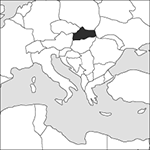
Source: MAPS IN MINUTES™ © RH Publications (1997)
Capital:
Bratislava
Area:
49,035 sq km (18,928 sq miles)
Population:
5,488,339 (2013 est)
Currency:
1 euro = 100 cents
Religions:
Roman Catholic 62.0%; Protestant 8.2%; Greek Catholic 3.8%
Ethnic Groups:
Slovak 80.7%; Hungarian 8.5%; Roma 2.3%
Languages:
Slovak (official); Hungarian; Roma; other minority languages
International Organizations:
UN; OSCE; Council of Europe; EU; NATO; OECD; WTO
A central European republic, formerly part of Czechoslovakia.
Physical
Slovakia is surrounded by Poland to the north, Ukraine to the east, Hungary to the south, and Austria and the Czech Republic to the west. The Carpathian mountains dominate the country. Some steppe grasslands are to be found in the south-eastern lowlands; one third of the country is cultivated and two-fifths is covered in forest. The Danube briefly forms the border between Slovakia and Hungary flowing towards Bratislava and finally on to the Black Sea.
Economy
Slovakia’s transition from a Soviet-era centrally planned to a free-market economy is almost complete. Principal industries include metal and metal products, food and drink, energy, and chemicals; agricultural crops include grains, potatoes, sugar beet, hops, and fruit. The principal exports are machinery, electrical equipment, vehicles, base metals, chemicals, and minerals.
History
A land belonging to the Hungarian crown since medieval times, Slovakia experienced an upsurge in nationalism in the late 18th and early 19th centuries. A final break with Hungary was made with the collapse of the Austro-Hungarian empire after World War I; Slovakia entered into union with the Czech lands. However, resentment at centralized control from Prague led to a declaration of autonomy within a federal Czecho-Slovak state on the eve of the Nazi annexation of Czechoslovakia in 1938; this was followed by nominal independence under German protection. With the end, in 1990, of the communist regime that had controlled Czechoslovakia since 1948, Slovak demands for independence grew and the Slovak Republic (with its capital at Bratislava) came into being on 1 January 1993 without conflict. Michal Kováč (1930–2016) was elected President and the nationalist leader Vladimir Meciar became Prime Minister. He was, however, defeated in the 1998 elections, when a coalition was formed under Mikulas Dzarinda. Meciar was also defeated in the 1999 presidential election, when Rudolf Schuster was elected, and again in 2004, by Ivan Gašparovič. Problems have been experienced in restructuring the Slovak economy, which was geared to labour-intensive heavy industry under the influence of Stalinism in the 1950s. Tensions remain between the Slovak majority and the ethnic Hungarian minority population. Slovakia joined NATO and the European Union in 2004 and adopted the euro as its currency in 2009. In 2006 elections the voters chose a coalition led by an anti-reform populist, Robert Fico of Smer–SD. This was replaced by a centre-right coalition led by Iveta Radičová in 2010. Following a crisis caused by parliament refusing to make a contribution to the eurozone bailout fund, a corruption scandal, and a snap election in 2012, Fico was back leading Slovakia’s first government since independence with an absolute majority. However, Fico’s attempt to become president in 2014 was thwarted when the non-partisan Andrej Kiska, a businessman and philanthropist, won the election. Fico continued as prime minister, but in 2015, was widely criticized for refusing to take any EU migrants. His party lost its majority in the 2016 elections, but he retained power by forming an unstable coalition with three small parties, including the Slovak National Party.
- delayed neutrons
- delayed response media
- delayed sweep
- delay equalizer
- delay line
- delay-power product
- delay time
- Delbrück, Max
- Delcassé, Théophile (1852–1923)
- delete
- deletion((in genetics))
- deletion residual
- Deleuze, Gilles (1925–95)
- del factor
- D'Elhuyar, Don Fausto
- Delian (altar) problem
- Delian League
- deliberation
- delimiter
- deliquescence
- delisting
- delivery failure
- delivery pressure
- Dell
- Dellinger fade-out